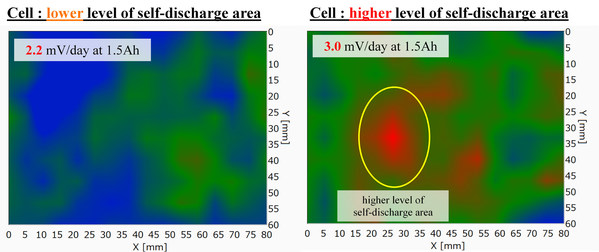The latest results will be presented at THE BATTERY SHOW in Detroit, USA, September 13-15, 2022 and Battery Safety Summit, October 12-14, 2022
KOBE, Japan, Sept. 14, 2022 /PRNewswire/ -- Integral Geometry Science Inc. (https://www.ig-instrum.co.jp/), a Japanese deep tech imaging startup, releases an innovative inspection system, which will enable battery manufacturers to detect products having ignition risks with higher-precision. The system is applied with a theory of inverse problem, developed by Professor Kenjiro Kimura of Kobe University Japan, for the first time in applied mathematics history.

Figure 1. Figure 1. Visualization of concentrated self-discharging area. Two images of two 1.5 Ah lithium-ion polymer batteries showing the degradation areas. The red areas on two images have higher electric current density comparing the other surrounding areas in the images. The right cell with higher contrast (right image) showed the faster cycle degradation after repeated charge-discharge cycles though two cells corresponding to left image and right one have almost same results of the aging test, few mV/day.
Storage batteries are used in many fields for the purpose of storing energy generated. Storage batteries are applied to aging tests before shipment, and only good batteries are distributed in the market. However, accidents such as ignition have occurred though batteries pass these safety tests. One of the causes of these accidents is that the electric current density inside the storage battery is spatially non-uniform, and the degree of this non-uniformity gradually increases as the battery is recharged and discharged. A sophisticated good/failure discrimination system is essentially required to eliminate theses batteries with non-uniform electric current density distribution.
Our visualization system can visualize and evaluate the spatial distribution of electric current density inside batteries by using measurement data of spatial distribution of the magnetic field outside the ones, which is originated from internal electric current flows.
The key technology and theory of this visualization system is an analytical solution of the inverse problem, that is to derive the electric current density distribution inside a storage battery from the measured data of the spatial distribution of the magnetic field. We have firstly derived its analytical solution. When nondestructive-testing based on this theory, although electric current is applied during measurement, level of the electric current is very low compared to the practical level of intrinsic battery power, and has no effect, so storage batteries that are determined to be good in terms of the spatial uniformity of electric current density distribution can be shipped as is.
Many manufacturers of vehicle-mounted storage batteries have used our visualization system, and we have contributed to the analysis of many failure locations and good/fail decisions (Figure 1). As a result of visualization, self-discharge points are brightly indicated.
Visualization of abnormalities about spatial distribution of electric current density caused by cycle degradation (Figure 2) and Li-NMR analysis by dismantling inspection have confirmed electrode degradation and metal precipitation at failure points (Figure 3).
When this next-generation pre-shipping quality control system based on electric current distribution visualization technology is introduced as a safety test, risks in the battery business are reduced and storage batteries with more safety assurance must be distributed. We will participate in an exhibition in the U.S. (THE BATTERY SHOW, dates : September 13-15, location : Suburban Collection Showplace, Novai, MI, booth number : #1250 / Battery Safety Summit, online, October 12-14, 2022).
![]() View original content to download multimedia:https://www.prnewswire.com/news-releases/diagnostic-imaging-against-storage-battery-explosion-toward-the-dissemination-of-next-generation-storage-batteries-301623991.html
View original content to download multimedia:https://www.prnewswire.com/news-releases/diagnostic-imaging-against-storage-battery-explosion-toward-the-dissemination-of-next-generation-storage-batteries-301623991.html